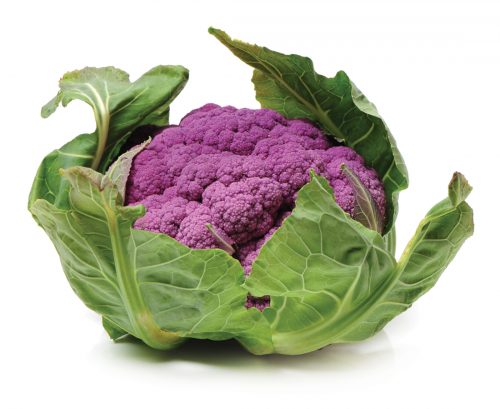
Yuzu
Hugely popular in Japanese cuisine, this citrus fruit originated in China. It’s not been widely used – or even known – in New Zealand until recent years but is now more readily available.
It looks like a bumpy lemon when ripe, and smells like a combination of mandarin, tangerine, grapefruit and lemon. It’s not used in the same way as other citrus however.
The inside is relatively dry and full of seeds so it’s not really eaten as a fruit and it’s the highly aromatic zest or sour juice you’re after.
Yuzu works really well in dressings, sauces, sorbets, marmalades and vinegars, and in baking you can replace lemon or orange zest with yuzu zest.
Like other citrus fruits, yuzu contain a range of antioxidant compounds, including vitamin C.
Purple cauliflower
So vibrant it almost looks fake, purple cauliflower isn’t dyed white cauliflower, it’s its own variety.
As with regular cauliflower, it’s at its best when the head is firm with tightly packed florets and blemish-free.
It tastes similar to white cauliflower but is slightly nuttier and sweeter. Prepare it in the same way – the colour may fade, depending on how much water you use while cooking, but you can still have purple cauliflower soup, pizza bases, mash, rice and even cauliflower cheese if you so desire. The purple colour will remain most striking when raw.
A cup of cooked cauliflower has 3g fibre, is a great source of vitamin C (60mg) and adds good amounts of folate and potassium; all for just 100kJ. The purple colour indicates the presence of anthocyanins, the same antioxidant compounds that colour dark berries and eggplants. And, like other brassicas, cauliflower also contain glucosinolates, which have been associated with reducing the risk of certain cancers.
Try substituting purple cauliflower for white cauliflower
in the following recipes:
• Warm spiced cauliflower salad
• Roasted cauliflower and kumara tray bake with
pomegranate dressing
• Spiced pumpkin, cauliflower and chickpea tray
bake
Fresh this month
Harvested in New Zealand gardens in June
Vegetables
Broccoli, Brussels sprouts, cabbages, cauliflower, celeriac, celery, fennel, kale, kumara, leeks, parsnips, rhubarb, silver beet, spinach, spring onions, squash, turnips.
Herbs
Mint, oregano, parsley, thyme.
Fruit
Apples, grapefruit, kiwifruit, lemons, limes, mandarins, nashis, navel oranges, passionfruit, persimmons, yuzu.
Here’s some more delicious recipes using cauliflower:
Broccoli and cauliflower staeks with fried capers
Article sources and references
- Arumugam A & Razi AF. 2017. Apoptosis as a mechanism of the cancer chemopreventive activity of glucosinolates: A review. Asian Pacific Journal of Cancer Prevention 19:1439-48https://www.ncbi.nlm.nih.gov/pubmed/29936713
www.healthyfood.com










